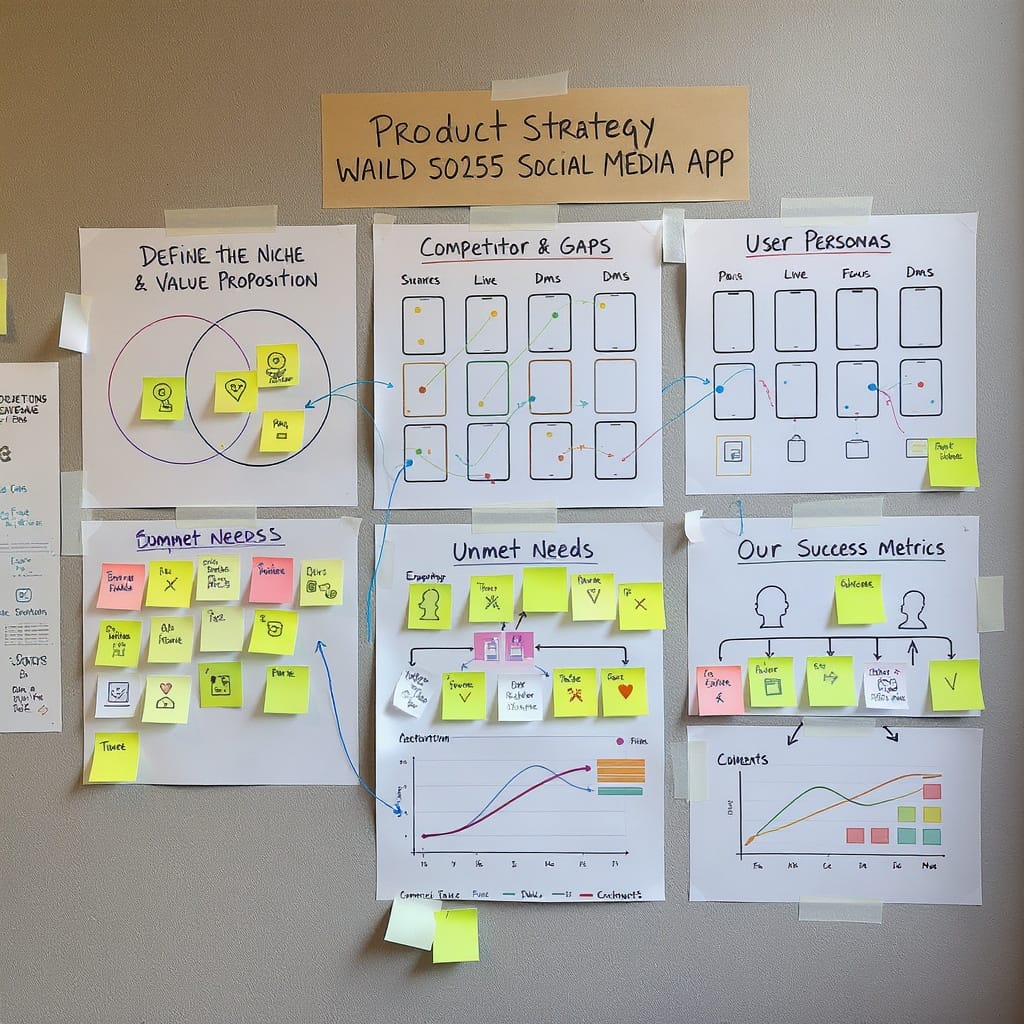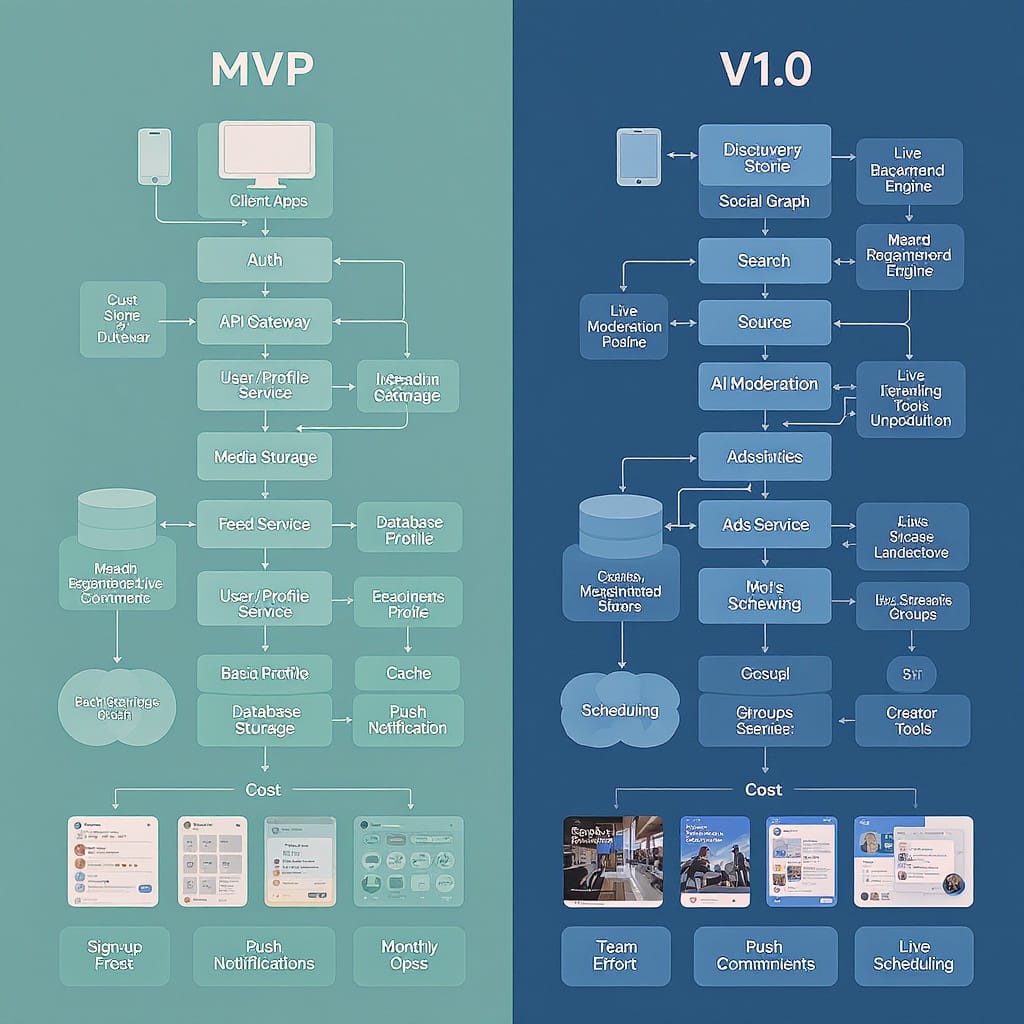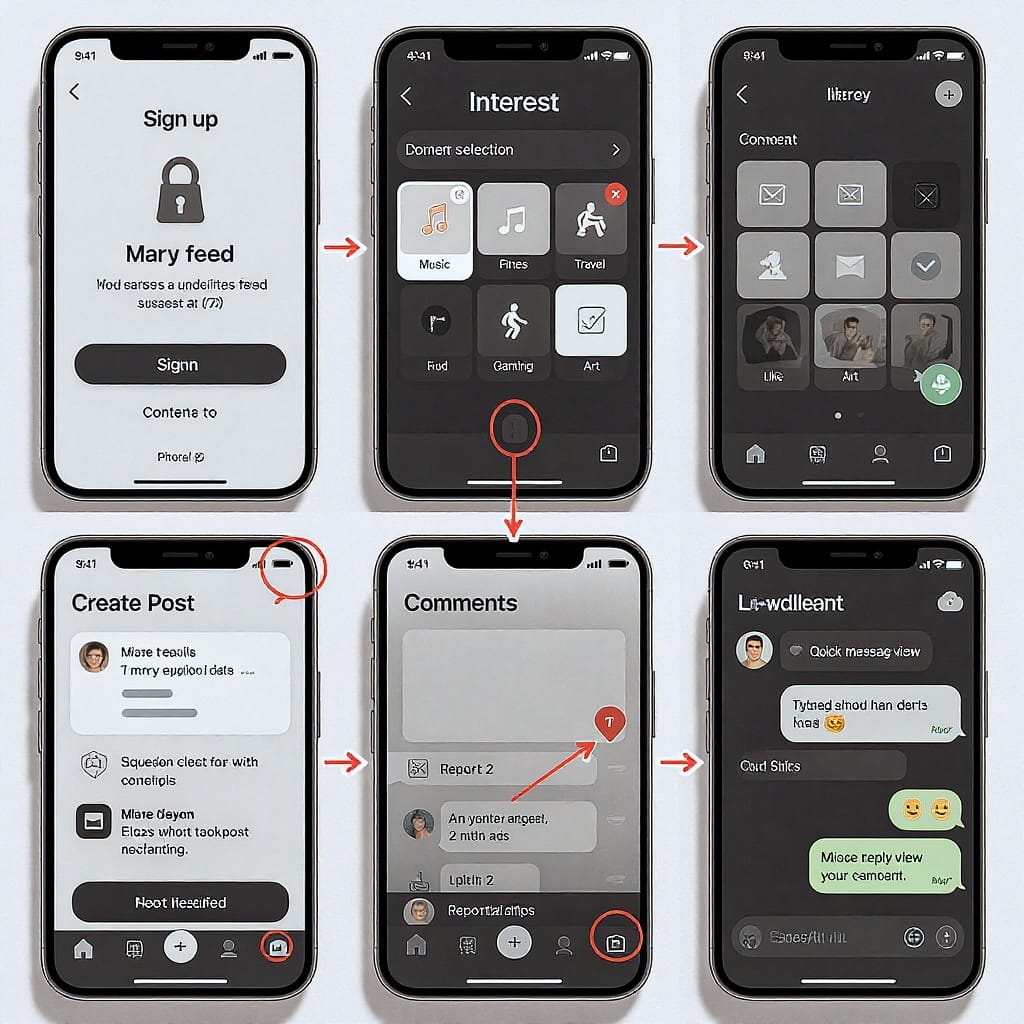How to Create a Social Media App in 2025: Features, Tech Stack, Costs, and a Step-by-Step Plan
Plan and build a social media app in 2025: define a niche, scope MVP vs V1, pick a tech stack, estimate costs, and ship safely, monetize, and grow.

Building a social media app in 2025 demands more than feature parity; it requires a sharp niche, trust-by-design, and a fast feedback loop from users to roadmap. This guide distills the strategy and execution details you need, from MVP scope and data modeling to moderation, monetization, and launch operations. Use it as a reference to ship a credible V1 quickly while laying foundations for scale and safety.
How to Create a Social Media App in 2025: Features, Tech Stack, Costs, and a Step-by-Step Plan


If you’re wondering how to create a social media app in 2025, you’re building into a mature but still fast-moving space. User expectations have risen (privacy, safety, speed), algorithms are scrutinized, and growth increasingly depends on smart network effects rather than brute-force ad spend. This guide breaks down the essentials: from niche definition and MVP scope to data models, moderation, monetization, security, and the step-by-step plan to ship a credible V1.
Define the Niche and Value Proposition
Start by identifying a specific problem and audience. A generic “new Instagram” is unlikely to break through; a focused, insight-driven product can.
Competitor patterns and gaps
- Instagram: High polish, visual-first, social graph-driven discovery. Gap: nuanced communities, deeper topic exploration, creator monetization predictability.
- TikTok: Entertainment-first, For You feed, algorithm-driven discovery. Gap: fine-grained controls, saving/following interest graphs, creator earnings stability outside the top.
- Reddit: Topic-based communities, pseudonymous, discussion depth. Gap: modern creation tools, mobile UX polish, safety at scale in smaller communities.
Identify unmet needs
- Safer small-group sharing and default-private networks.
- Interest-first discovery with transparent controls.
- Collaborative creation (co-posts, templates), better on-ramps for new creators.
- Time-bound spaces (events, live rooms) with moderation guards.
- AI-assisted prompts, captions, summarization with user control and labeling.
User personas
- Creators: Want reach, tools, analytics, and fair monetization.
- Explorers/Lurkers: Want signal over noise, relevant content quickly.
- Moderators/Community leaders: Need dashboards, filters, and clear appeals processes.
- Brands/SMBs: Want simple campaign tools, verified presence, conversion attribution.
Success metrics
- North-star KPI: “Weekly Active Contributors” (users who post or comment at least once/week) or “Meaningful Interactions per Weekly Active User.”
- Guardrails: 7-day retention, time-to-first-like/comment, session frequency, % of sessions with high-quality interactions.
- Retention cohorts: Track D1/D7/D30 by acquisition channel, persona, and community join status. Set targets (e.g., D7 ≥ 25% for early adopters) and iterate on onboarding.
Scope the MVP vs. V1.0
Resist scope creep. Build the smallest set that powers a valuable loop.
MVP must-haves
- Authentication: Email/phone + OAuth (Apple/Google), age gate.
- Profiles: Avatar, bio, links, basic privacy settings.
- Social graph: Follow/unfollow, block/report.
- Posts: Text, image, short video; basic camera/upload; captions; hashtags.
- Feed: Reverse-chron plus simple “For You” ranking; infinite scroll.
- Interactions: Likes, comments, basic mentions.
- Search: Users, hashtags, simple keyword.
- Notifications: Push + in-app for follows, likes, comments.
- Admin basics: User/post takedown, ban, content flags.
- Moderation essentials: Reporting, queue, simple ML signals, human review.
V1.0 additions (post-MVP)
- Messaging: 1:1, read receipts, attachments.
- Collections/playlists, drafts, scheduled posts.
- Advanced creation: Filters, trimming, templates, collaborative posts.
- Topic/interest onboarding, suggested follows.
- Creator tools: Analytics, link-in-bio, tipping or subscriptions.
- Localization: 2–3 key languages, RTL support.
- Accessibility: Captions, VoiceOver/TalkBack labels, contrast, haptics.
- Admin: Audit logs, rate-limit dashboards, appeal workflow.
| Feature | MVP | V1.0 | Notes |
|---|---|---|---|
| Auth | Email/Phone + OAuth | MFA, Device trust | Age gate at signup |
| Posts | Text/Image/Short Video | Drafts, Schedules, Templates | Keep transcodes server-side |
| Feed | Chron + Light Rank | Personalized Ranking | Start simple for debuggability |
| Moderation | Report + Review Queue | ML Prioritization, Appeals | Track audit trails early |
| Monetization | — | Tipping/Subscriptions | Delay until retention stabilizes |
Design for UX and Network Effects
- Onboarding flows: 60-second path to value. Progressive profiling, topic picks, suggested follows, import contacts, privacy defaults.
- Invite/referral mechanics: Single-use codes, deep links, referral rewards (non-monetary early on), contact sync with explicit consent.
- Seeding content: Recruit 50–100 creators, staff picks, starter packs, prompt calendars, “first 30 posts” campaign with featured placement.
- Accessibility: WCAG 2.2 AA; auto-captions for video, adjustable text, reduced motion, color-safe palettes.
- Localization: I18n from day one; separate copy files, avoid hard-coded text; plan for community translations.
- Creation tooling: Camera with stabilization, crop/trim, auto-captions, music/voiceover slots, AI-assisted caption prompts and alt-text with review.
Choose Architecture and Tech Stack
Aim for a pragmatic monolith to start, modularized for future extraction. Optimize for developer velocity and observability.
Mobile apps: Native vs. Cross‑platform
| Option | Pros | Cons | When to choose |
|---|---|---|---|
| Native (Swift/Kotlin) | Best performance, camera/media, platform polish | Two codebases, higher staffing | Heavy video/AR, large budgets |
| React Native | One codebase, strong ecosystem, fast iteration | Bridges for advanced media, perf tuning | General social apps, small-medium teams |
| Flutter | High FPS, consistent UI, good tooling | Dart hiring pool smaller, native APIs via plugins | Custom UI, multi-platform roadmap |
Recommendation: Start with React Native or Flutter unless your USP is camera/video performance at the edge, in which case go native.
Backend and infrastructure
- Backend frameworks: Node.js (NestJS), Python (Django/DRF or FastAPI), Ruby on Rails. Choose one your team knows; each can scale to millions with good architecture.
- Data stores: PostgreSQL (primary), Redis (caching, rate limiting, ephemeral queues).
- Object storage + CDN: S3/Cloud Storage + CloudFront/Cloudflare. Transcode video with Elastic Transcoder or MediaConvert/Cloud Transcoder.
- Real-time: WebSockets (Socket.IO, uWebSockets), or server-sent events for notifications; consider managed Pub/Sub.
- Push: APNs (iOS), FCM (Android); aggregators like OneSignal can simplify.
- Background workers: Sidekiq (Ruby), Celery/RQ (Python), BullMQ/Temporal (Node), plus a message queue (SQS, RabbitMQ, or Kafka as you scale).
- Observability: Logs (ELK or OpenSearch), metrics (Prometheus + Grafana), tracing (OpenTelemetry + Jaeger/Tempo).
- Infra-as-code: Terraform or Pulumi; CI/CD with GitHub Actions.
Model Data and the Feed
A robust data model is the backbone of your app’s speed and reliability.
Core schemas (simplified)
-- PostgreSQL
create table users (
id bigserial primary key,
handle varchar(32) unique not null,
display_name varchar(80),
email citext unique,
phone varchar(32),
bio text,
avatar_url text,
is_private boolean default false,
created_at timestamptz default now()
);
create table relationships (
follower_id bigint references users(id) on delete cascade,
followee_id bigint references users(id) on delete cascade,
created_at timestamptz default now(),
primary key (follower_id, followee_id)
);
create table posts (
id bigserial primary key,
author_id bigint references users(id),
kind smallint not null, -- 0=text,1=image,2=video
text text,
media_url text,
thumb_url text,
aspect_ratio numeric(4,2),
visibility smallint default 0, -- 0=public,1=followers,2=private
created_at timestamptz default now(),
deleted_at timestamptz
);
create table likes (
user_id bigint references users(id) on delete cascade,
post_id bigint references posts(id) on delete cascade,
created_at timestamptz default now(),
primary key (user_id, post_id)
);
create table comments (
id bigserial primary key,
post_id bigint references posts(id) on delete cascade,
author_id bigint references users(id) on delete cascade,
text text not null,
parent_id bigint references comments(id), -- threaded
created_at timestamptz default now()
);
create table reports (
id bigserial primary key,
reporter_id bigint references users(id),
target_type smallint, -- 0=post,1=comment,2=user
target_id bigint,
reason smallint, -- taxonomy
note text,
status smallint default 0, -- 0=open,1=review,2=closed
created_at timestamptz default now()
);Indexes: GIN index for full-text search on posts.text, composite indexes on relationships (followee_id, created_at) for fan-out, and on likes/comments for counts.
Feed delivery: fan-out-on-write vs. fan-out-on-read
- Fan-out-on-write: Push new post IDs into followers’ feed tables or Redis lists at write time. Pros: fast reads; cons: heavy writes for large creators, backfill complexity.
- Fan-out-on-read: Compute the feed on demand by joining followees’ recent posts. Pros: simple writes; cons: heavier read joins, need caching.
For MVP, use fan-out-on-read with caching. For power-creators, add a hybrid for their followers.
-- Example materialized view to seed a home feed (refresh periodically)
create materialized view home_feed as
select p.id as post_id, r.follower_id as user_id, p.created_at
from posts p
join relationships r on r.followee_id = p.author_id
where p.deleted_at is null
order by p.created_at desc;Ranking signals
- Recency: Newer posts get a base boost with time decay.
- Affinity: Past interactions between user and author.
- Quality: Early like/comment velocity, completion rate for videos, reports negative weight.
- Diversity: Penalize repeats from the same author; introduce new accounts.
// Pseudocode ranking function
type Signals = {
recencyHours: number;
affinityScore: number; // 0..1
qualityScore: number; // 0..1
diversityPenalty: number; // 0..1
};
function rank(s: Signals): number {
const timeDecay = Math.exp(-s.recencyHours / 24); // 1-day half life
const base = 0.4 * timeDecay + 0.35 * s.affinityScore + 0.35 * s.qualityScore;
const penalized = base * (1 - 0.3 * s.diversityPenalty);
return penalized;
}Caching, queues, background workers
- Cache layers: Redis for hot timelines and counts; cache invalidation on like/comment mutations.
- Queues: SQS/RabbitMQ for thumbnail generation, video transcodes, notification fan-out.
- Workers: Idempotent tasks, retries with backoff, dead-letter queues, and observability.

Privacy, Safety, and Compliance
- Age gates: Comply with COPPA and regional age thresholds; restrict under-13 features; parental consent where required.
- Consent and data rights: GDPR/CCPA-compliant privacy policy, DSR/DSAR tooling (export, delete, rectify); data minimization; purpose limitation.
- Moderation pipeline:
- Pre-screen media with ML classifiers and hash matching where lawful.
- User reporting with clear categories; in-app guidance.
- Triage queue with priority scoring; batch tools for moderators.
- Human review SLAs; consistent policy taxonomy; appeal path.
- Audit logs for every action; evidence retention policy.
- Safety features: Block/mute, restricted DMs, comment controls, shadow-bans for spam, rate-limits on new accounts.
- Transparency: Labels for AI-assisted content, periodic safety reports, clear community guidelines.
Monetization and Growth Strategy
- Revenue options:
- Ads: Native feed ads, sponsor slots; start late and light; maintain ad load caps.
- Subscriptions: Premium features (advanced analytics, customization), ad-free tier.
- Creator monetization: Tips, subscriptions, paywalled posts, affiliate links.
- Virtual goods: Stickers, boosts, badges; watch for abuse.
- Brand partnerships: Sponsored challenges, co-branded communities.
- Balance engagement vs. revenue: Protect core loops; guardrails on ad density; do not throttle organic reach to juice paid options early.
- Fraud prevention:
- Payments: 3DS where available, velocity checks, device fingerprinting.
- Payouts: KYC/KYB, tax forms, delays for chargeback windows, anomaly detection.
- Abuse: Bot detection (behavioral signals), link risk scoring, invite abuse limits.
- Payout workflow: Use a managed provider (e.g., Stripe Connect, Adyen MarketPay) to handle KYC, compliance, and mass payouts.
Roadmap, Team, and Costs
Suggested MVP timeline (8–12 weeks)
- Weeks 0–1: Discovery, scope, design system, technical spike (media pipeline, feed).
- Weeks 2–4: Auth, profiles, posts upload, basic feed, likes/comments, search.
- Weeks 5–6: Notifications, reporting/moderation queue, admin basics, analytics SDKs.
- Weeks 7–8: Polish UX, performance, accessibility, localization groundwork.
- Weeks 9–10: Closed beta, bug triage, infra hardening, rate limits.
- Weeks 11–12: Store submissions, landing site, support playbook.
Team roles
- PM (0.5–1 FTE), Product Designer (1), Mobile Engineer(s) (1–2), Backend Engineer (1–2), QA/Automation (0.5–1), DevOps/SRE (0.5).
- Augment with a part-time Trust & Safety advisor and community manager.
Build vs. buy
- Buy initially: Auth (Auth0/Clerk/Cognito), analytics (Mixpanel/Amplitude), crash reporting (Sentry), push orchestration (OneSignal), media processing (Cloud services), moderation ML (commercial API).
- Build core: Feed ranking, social graph, creation experience, community tools.
Rough cloud budget (early stage)
| Item | Monthly Estimate | Notes |
|---|---|---|
| Compute (App + Workers) | $400–$1,500 | Autoscaled containers |
| PostgreSQL (Managed) | $200–$800 | Primary + backups |
| Redis (Managed) | $100–$400 | Caching + queues |
| Object Storage | $50–$300 | Depends on uploads |
| CDN Egress | $200–$1,000+ | Video heavy can spike |
| 3rd-party SDKs | $200–$800 | Auth, analytics, push |
Vendor selection criteria
- SDK quality and mobile footprint; offline support.
- Transparent pricing, volume discounts, egress fees.
- Data residency/compliance (GDPR), SOC2/ISO 27001.
- SLAs, support responsiveness, roadmap alignment.
- Data portability and lock-in risk.
Launch and Iterate
- Beta strategy: Closed cohorts seeded with creators; gated invites; weekly updates; measure NPS and qualitative feedback.
- Distribution: TestFlight/Play testing; store listings with clear positioning; ASO around your niche; social proof on the landing page.
- Analytics setup: DAU/MAU, D1/D7/D30 retention, K-factor (invites → joins), ARPU (post-monetization), core actions per session, time-to-first-interaction.
- A/B testing: Start with lightweight experiment frameworks; test onboarding, suggestions, notification cadences; enforce guardrails to prevent regressions.
- Community playbook: Moderator guidelines, creator onboarding kits, content calendars, spotlight programs; weekly town-halls.
- Feedback-driven sprints: Ship small, evaluate cohorts, keep a ruthless backlog prioritization tied to the north-star KPI.
Security and Scalability
- Secure auth: OAuth 2.1/OpenID Connect; MFA (TOTP, push); device-based risk scoring; refresh token rotation.
- Rate limiting and abuse prevention: Token bucket per-IP/device/user; circuit breakers for hot endpoints; Captcha on risk.
- Data protection: TLS 1.2+; encryption at rest (KMS); secrets management (Vault/SM).
- Horizontal scaling: Stateless app nodes; sticky sessions avoided; use message queues for background work; shard when necessary (by user ID ranges).
- Media pipeline: Pre-signed URLs for uploads; antivirus scanning; transcode workers isolated; DRM if needed.
- Observability: Structured logs with trace IDs; RED/USE metrics; SLOs for feed p95 and upload success; alerting on error budgets.
- Incident response: On-call rotation, runbooks, status pages, postmortems with action items; practice game days.
Step-by-Step Plan: From Zero to V1
- Define niche, personas, and problem statement. Write your north-star KPI.
- Wireframe the core loop (create → share → feedback → return). Validate with 5–10 target users.
- Choose tech stack (mobile, backend) and set up repo, CI/CD, IaC.
- Implement auth, profiles, posting, and a chronological feed.
- Add likes/comments, notifications, search, and basic moderation.
- Integrate media storage/CDN, background workers, and push.
- Ship onboarding (interests, suggestions) and invite/referral flows.
- Run closed beta; instrument analytics; iterate on retention issues.
- Add lightweight ranking and caching; harden rate limits and safety.
- Localize initial markets; accessibility pass; prepare store assets.
- Launch open beta; support and community playbook live.
- Prioritize V1.0 features (messaging, creator tools) based on data.
Final Thoughts
Learning how to create a social media app in 2025 is about smart focus: solve a real problem for a defined community, ship a lean but lovable MVP, build trust through safety and privacy, and iterate with data. Choose a tech stack your team can move fast with, avoid premature microservices, and invest early in moderation and observability. When in doubt, optimize for meaningful interactions—and the network will grow.
Summary
This playbook outlines how to define a niche, scope an MVP, and assemble a pragmatic stack that prioritizes speed, safety, and observability. Follow the step-by-step plan to reach a credible V1, then iterate with data-driven improvements to retention, quality, and community health.




